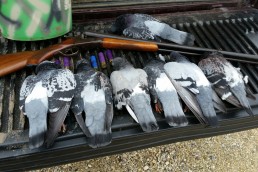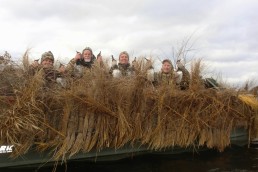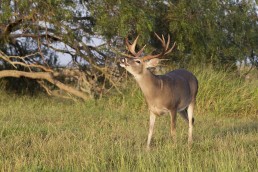Fastest-growing Shooting Sport in the Midwest: Pigeon Hunting
SHARE THIS POST
My cousin Ken and I set out our six Wing Kings pigeon decoys along the edge of last year’s cornfield. Ken had scouted the field and knew within the hour of when the local flock would drop in to feed.
I finished the set with a Mojo-teal “spinner” (motion decoy) near the center of the decoys and then went back to our makeshift blind. About 25 minutes later, a flock of eight or 10 pigeons tried to land in the decoys. Three of the pigeons stayed behind on the ground. Another small flock, and then two singles, also tried to land. We ended the day with seven birds, and all were fat and well fed from a dairy farm about one-quarter mile down the road.
Truth is, wild pigeons will surprise you, as these are harder to hit than you might think. They are fun to decoy and are much better for eating than most realize. With a no-closed season or limits, they offer realistic duck or goose hunting practice year ‘round.
The same principles that help you bag waterfowl apply directly to feral pigeon hunting. And trust me, if you can hit a pigeon that knows it’s being shot at, a mallard or Canada goose will be an easy target.
American hunters were largely introduced to pigeon hunting after an article on decoying feral pigeons appeared in an article a few years back. A company called Soar-No-More offered guided pigeon hunts and pigeon decoys. They now also offer hunting videos, other decoys and motorized decoys.
“With the endless amounts of pigeons available in our country, pigeon hunting provides offseason sport for your friends, family and bird dog,” said Neal Hunt, of SNM decoys, the original decoy producer, on why pigeon hunting has become so popular. “No seasons and no limits—what more could you ask for?”
Scouting
Dairy farms are prime places for feral pigeons, and silos and barns provide nesting and roosting cover. Also, the cattle feeding provide a non-stop buffet for the birds.
Pigeons are bad tenants, and repay the farm owners by fouling the silage and equipment with their droppings. Look around gravel pits, cement factories and old abandoned buildings, as these will all hold pigeons. I’ve also observed dozens of pigeons living under freeway overpasses. The birds will often feed on adjacent farms or grain fields. Often, pigeons can be spotted feeding in cut-down, harvested cornfields or grain fields.
Just like with waterfowl, the easiest place to decoy these birds into is a field that they are already using. Find that field, obtain permission, and get in before first light to set up your decoys. Most times, the birds will arrive just after sun up. The last few hours of light are also a prime time to hunt them. Pigeons can also be “jump shot” by kicking them out of silos, sheds or barns. This is only with the consent of the farmer and should be done so with extreme caution, as you could be shooting right over cattle and around power lines.
As mentioned, barn pigeons tend to wear their welcome out quickly by fouling silage. A dairy farmer’s milk check is his livelihood, and cows sickened by contaminated silage don’t provide salable milk. They also don’t need expensive tractors and combines “painted” white with pigeon droppings. Often, permission to hunt pigeons is much easier to obtain than permission to hunt the waterfowl. I suggest you ask politely, and always respect the farmer’s safety rules. Most don’t want any shooting close to the farmhouse or near their cow yards where the cattle could be frightened by gunfire. If the answer is no, be polite and ask if any other farmers in the area who might want their local pigeons controlled. If yes, offer something in return, and remember to thank them. Also, close any gates and also pick up all dead birds and spent shells. Cows have a funny habit of eating all sorts of weird stuff so scour the ground for shot shell wads and casings.
Are you enjoying this post?
You can be among the first to get the latest info on where to go, what to use and how to use it!
Decoys
To be honest, good, high-quality decoys are an investment. They will give you years of service and you will end up killing dozens of birds over them. In a pinch, you can also repurpose old crow or coot decoys, painting them to look like pigeons. The “spinners” you use to hunt waterfowl will work perfectly for pigeons too. By the time they figure out it’s a mallard, teal or wood duck decoy, it’s usually too late.
Place decoys with upright heads on the edge of the spread as “sentries” and feeders scattered around. I also make sure to pair up a few decoys. Again, we use a dozen Soar-No-More decoys as well as some of the newer Wing Kings.
Decoy sets
Barn pigeons tend to be happy-go-lucky birds that just sort of drop into feed with half the flock already on the ground. I place mine in a loose semi-circle or an “X” pattern. Just make sure to leave the landing zones for incoming birds. A “spinner” or spinning-wing motorized decoy is a big draw for these birds. I often place the same plastic ears of field corn I use for waterfowl hunting—as use of real corn for waterfowl is prohibited by federal law—among the decoys and near the landing zone. The fake ears of corn provide an extra draw and visual cue for the incoming birds. Freshly killed birds can be propped up on coat hanger wire stands in the decoys. I’ve also had pigeons decoy into duck and goose decoys set in cut cornfields and into dove decoys by a waterhole.
Guns and loads
Your favorite waterfowl shotgun will be a great pigeon-hunting gun; the shots at passing or decoying pigeons will mirror shots at waterfowl and are excellent wingshooting practice. Unlike expensive waterfowl loads, pigeons are best hunted with cheaper shells and light loads of fine shot. If you’re hunting pigeons only, standard trap or game loads loaded with 1 or 1 1/8 ounces of lead and 7 1/2 or 6 shot will work wonders. Pigeon hunting is also a good way to use up old odds and ends of shotgun ammunition. Use full choke for pass shooting, modified or improved over decoys.
If you’re hunting doves on public land or during the September early Canada goose season, possession of lead shot loads is prohibited. For doves, we use 1 ounce of steel 6 shot in a 12-gauge or 7/8 ounce in 20-guage shotguns, and it seems to kill pigeons cleanly. Modified seems to be the best all-around choke tube to use. Once again, it’s a good way to use up older steel rounds that you don’t want to shoot at waterfowl.
Pigeon as table fare
You’ve set your decoys and have cleanly killed a few birds. Now what?
First, lay the bird on its back and skin out the breast. Fillet the meat off the breastbone with a sharp knife, and then rinse and soak the fillets in cold, salted water. You will have cuts of lean red meat that taste a lot like wood duck. Use the pigeon breast fillets in any recipe that calls for red meat or grind them into burger to use in sausage or chili. Pigeon meat also works great for stews or for stir-fry recipes.
Cooks who wish to use the whole bird can pluck the birds and then stuff them with seasoned rice. Stuffed, whole-roasted pigeons are considered a delicacy in China and the Middle East. One of my personal favorites is a seasoned pigeon breast fillet cooked in a covered roaster and served over brown rice and mushrooms.
Despite the bad reputation they have earned around barnyards, pigeons are great game birds. Pigeon hunting is also a great training tool for teaching younger hunters. My son Adam learned to hunt shooting pigeons with my old .410 shotgun. When I switched him over to a 20 gauge and steel shot, he was hitting Canada geese quite nicely.
The sport of pigeon hunting will continue to evolve and grow in popularity.
MWO
SHARE THIS POST
Did you enjoy this post?
You can be among the first to get the latest info on where to go, what to use and how to use it!
Ron Stresing
Ron Stresing has fished since age 4 and hunted since age 12, with a lifelong passion for both. He tries to convey the lessons learned over a lifetime of hunting and fishing in Wisconsin. He also writes a column on shotguns for On Wisconsin Outdoors.




